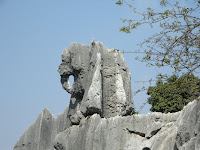

As mentioned in my previous blog entry, the Yunnan province is a very culturally diverse place. Because it borders three countries (Burma, Laos and Vietnam) it's not surprising that Yunnan is home to numerous ethnic minorities. According to Yunnan Nationalities Museum, China is home to more than fifty minorities and Yunnan has a little bit of everybody! Just for perspective, most (over 1 billion) of the Chinese you see are descendants of the Han people. The other minorities include the Zhuang, Hui, Can, Naxi, Dai and the list goes on (for the other fifty or so ethnicities). Kunming celebrates all of the minorities in the Nationalties Museum and Minority Park across the street.

The Museum, which sounds boring, really was quite interesting. You get a chance to explore the costumes, art, architecture, history, lifestyle and most importantly, musical instruments of China's people. What I liked most about the Museum (besides the instrument exhibit) was the fact that at 10am, we were the only people in the museum! After paying the student rate of 10元 for admission, we were free to roam the grounds, uninterrupted and free from the shrieks of the unsupervised children.
The affiliated Minority Park was a little more spendy than the museum (70元/person) but don't forget your student ID to get 50% off. This place was more of a tourist destination as there were junk shops everywhere
 and people following you, asking you to dress up like one of the races and take overpriced photos. However, it was still an enjoyable place. 26 of the Chinese minorities were represented with actual reproductions of ancient villages and buildings. If you're lucky, you can catch a performance in the local style. When we stopped for some cross-bridge noodles (过桥米先) we were treated to a Naxi-style song and dance. After that, we wandered around the park to each of the villages. The only problem we faced was that because we waited until about 1pm to enter the park, we
and people following you, asking you to dress up like one of the races and take overpriced photos. However, it was still an enjoyable place. 26 of the Chinese minorities were represented with actual reproductions of ancient villages and buildings. If you're lucky, you can catch a performance in the local style. When we stopped for some cross-bridge noodles (过桥米先) we were treated to a Naxi-style song and dance. After that, we wandered around the park to each of the villages. The only problem we faced was that because we waited until about 1pm to enter the park, we  didn't have enough time to visit all 26 villages. By the time we made it to the Tibetan village, they were closing down. Fortunately, we caught the zip-line ride before they went home. That was the best 15元 I spent all day.
didn't have enough time to visit all 26 villages. By the time we made it to the Tibetan village, they were closing down. Fortunately, we caught the zip-line ride before they went home. That was the best 15元 I spent all day.














